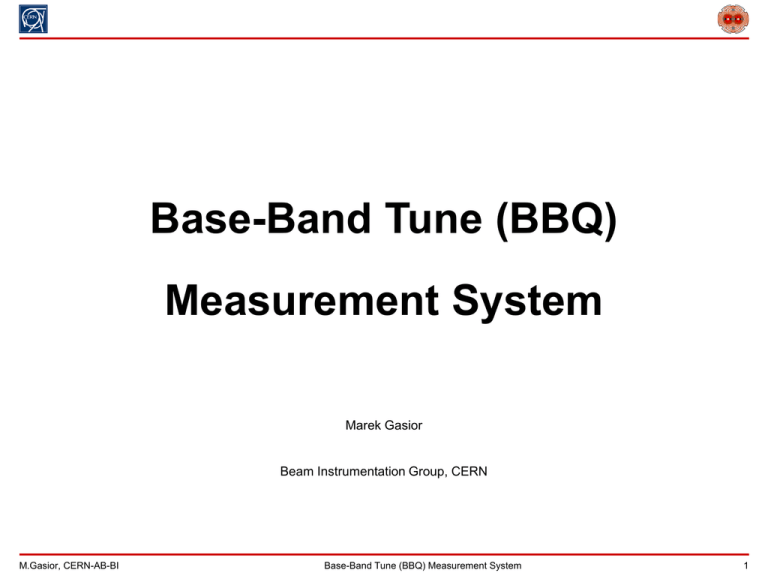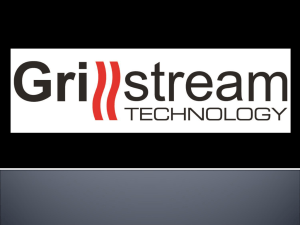Talk
advertisement

Base-Band Tune (BBQ) Measurement System Marek Gasior Beam Instrumentation Group, CERN M.Gasior, CERN-AB-BI Base-Band Tune (BBQ) Measurement System 1 Tune measurement – The principle Beam oscillations are observed on a position pick-up Oscillations of individual particles are incoherent – an excitation needed for “synchronization” Small beam oscillation signals in the presence of large revolution frequency content due to the fact that each bunch appears in the pick-up only once per revolution Oscillations are usually observed in the frequency domain (separation from the strong background) M.Gasior, CERN-AB-BI Base-Band Tune (BBQ) Measurement System 2 Tune measurement – Classical approach Linear processing of position pick-up signals Dynamic range problems: revolution frequency content is large with respect to the betatron content • large kicks required • accurate gain control needed (signal cannot be clamped) If only small kicks are affordable (to limit beam emittance blow-up), complicated solutions needed. e.g. • resonant pick-up (does not work with single bunches) • beam centering (mechanics or electronics), the limit is the hybrid M.Gasior, CERN-AB-BI Base-Band Tune (BBQ) Measurement System 3 Classical approach – “One betatron harmonic filtering” 3 dB sc (t ) cos(2π f b t ) sb1 (t ) (t nT ) so1 (t ) (t nT ) n n Sc ( f ) 1 n n 1 n Sb1 ( f f b ) f f b Sb1 ( f f b ) f f b So1 ( f ) f 2T T T T T n n n bunchspectrum 3 dB cut-off 0.133 bunchlength The LHC bunch length (4) is about 1 ns and the corresponding bunch spectrum cut-off is about 500 MHz With just one bunch in the machine the revolution spectral lines are spaced by 11 kHz, so there are some 50 000 of these and some 100 000 betatron lines When using the classical “one betatron harmonic filtering” method, one observes only 0.00001 (-100 dB) of the spectral content This results in very small signals, requiring low noise amplifiers and mixers, which have small dynamic ranges; they can be easily saturated by a huge revolution content M.Gasior, CERN-AB-BI Base-Band Tune (BBQ) Measurement System 4 Tune measurement – Direct Diode Detection (3D) Peak detection of position pick-up electrode signals (“collecting just the cream”) frev content converted to the DC and removed by series capacitors fb modulation moved to a low frequency range (as after the diodes fb is on much longer pulses) A GHz range before the diodes, after the diodes processing in the a kHz range Large sensitivity Works with any position pick-up Impossible to saturate (large frev suppression already at the detectors + large dynamic range) Low frequency operation after the diodes • High resolution ADCs available • Signal conditioning / processing is easy (powerful components for low frequencies) M.Gasior, CERN-AB-BI Base-Band Tune (BBQ) Measurement System 5 Direct Diode Detection – The principle sb1 (t ) sb (t ) (1 )1 cos(2π f b t ) sb 2 (t ) sb (t ) (1 )1 cos(2π f b t ) sd(t) beam relative offset = 0.1 betatron oscillation relative amplitude = 0.05 simulated tune value q = 0.1 filter time constant = 10T (T – revolution period) storage capacitor Cf = Cpu (PU electrode capacitance) Electrode 1 signal Electrode 2 signal Signals of both peak detectors Detector signal difference M.Gasior, CERN-AB-BI Base-Band Tune (BBQ) Measurement System 6 Direct Diode Detection – The principle Signals of both peak detectors Detector signal difference = 0, = 0.01 q = 0.1, Cf = Cpu =T = 100 T 4 bunches = 100 T M.Gasior, CERN-AB-BI Base-Band Tune (BBQ) Measurement System 7 Direct Diode Detection – Diodes not perfect Signals of both peak detectors Detector signal difference = 0, = 0.01 q = 0.1, Cf = Cpu 4 bunches = 100 T beam not centered one bunch 10 % larger M.Gasior, CERN-AB-BI Base-Band Tune (BBQ) Measurement System 8 Direct Diode Detection – Base band spectrum q 0.5 q 0.5 T 1 exp j 2π f T S f ( f ) 1 j 2π f T M.Gasior, CERN-AB-BI f Sf r T ~ 3T 2 2 4 2 2 2 coth S f fr T π 2 Base-Band Tune (BBQ) Measurement System 9 Architecture of the Base Band Q (BBQ) Measurement System Detector box (for one PU electrode) M.Gasior, CERN-AB-BI Analog front-end box (2 channels) Base-Band Tune (BBQ) Measurement System 10 BBQ systems at CERN LHC, SPS Machine Front-End Acquisition LHC “constant frev type” 24 bits (up to 100 kHz) SPS “constant frev type” 24 bits PS “constant frev type” 16 bits (up to 40 MHz) LEIR “varying frev type” 16 bits PSB “varying frev type” 16 bits PS, PSB, LEIR Normalized magnitude [dB] 0 SPS PSB -20 -40 PS -60 -80 -100 3 5 1 2 3 5 10 2 3 5 100 2 3 5 1000 2 3 5 10000 Frequency [kHz] BBQ system operational at RHIC Tested at Tevatron Will be operational at the CNAO hadrontherapy machine M.Gasior, CERN-AB-BI Base-Band Tune (BBQ) Measurement System 11 SPS BBQ M.Gasior, CERN-AB-BI Base-Band Tune (BBQ) Measurement System 12 SPS BBQ – Transverse damper noise 1 bunch LHC pilot, 5109 p+, 26-450 GeV Damper system ON No explicit beam excitation Damper system OFF M.Gasior, CERN-AB-BI Base-Band Tune (BBQ) Measurement System 13 SPS BBQ – Low-pass filtering (no filters) Measurement with the fixed target beam (a few thousand small bunches), no excitation BOSC – a homodyne tune measurement system A low-pass filter before the diodes cleans up the bunch longitudinal shape • Important beam noise filtering at a small expense of a few dB signal loss, resulting in an important SNR improvement • Similar effects seen on the PS and PSB M.Gasior, CERN-AB-BI Base-Band Tune (BBQ) Measurement System 14 PS EASTB, regular kick every 10 ms M.Gasior, CERN-AB-BI TOF, regular kick every 10 ms Base-Band Tune (BBQ) Measurement System 15 PSB LHC25A, R3, no kick M.Gasior, CERN-AB-BI Same, kick 20 V (a % of the standard kick) Base-Band Tune (BBQ) Measurement System 16 LEIR NOMINAL, regular kick 500 V, every 10 ms M.Gasior, CERN-AB-BI Same, no kick Base-Band Tune (BBQ) Measurement System 17 (Sound card) Record of the RHIC BBQ signals ramp squeeze RF switching injections Q' too small Horizontal plane (L) Vertical plane (R) about 10 minutes M.Gasior, CERN-AB-BI Base-Band Tune (BBQ) Measurement System 18 Spectra of the RHIC BBQ signals Hor. M.Gasior, CERN-AB-BI Ver. Base-Band Tune (BBQ) Measurement System 19 RHIC BBQ measurements – Collisions Store beginning 5 hours later (end of the store) H plane V plane M.Gasior, CERN-AB-BI Base-Band Tune (BBQ) Measurement System H plane V plane 20 Conclusions BBQ advantages BBQ disadvantages Sensitivity (noise floor in the nm range for intense beams) Interference: operation in the low frequency range It is sensitive to the "bunch majority“ (gating needed to measure separate bunches) Simplicity and low cost • no timing, no resonant PU, no movable PU, no hybrid, no mixers, it can work with any PU Very robust for saturation Base band processing and acquisition • excellent 24 bit audio ADCs available • Signal conditioning / processing is easy (powerful components for low frequencies) • Independence of the machine filling pattern Flattening out of the beam dynamic range (small sensitivity to number of bunches) M.Gasior, CERN-AB-BI Future development Gating a bunch or a group of bunches (successful proof of principle done with beam) Continuous head-tail chromaticity measurement (tests with beam and some theoretical studies done) Base-Band Tune (BBQ) Measurement System 21 Extra slides: Direct Diode Detection – SNR limits = 100 T GD 2 VnC T R f C f C pu 1 exp j 2π q T ( R f C f ) 1 j 2π q π C pu C f 4k T 2 R f 2 2 e I RD I nA 2 R f VnA 2 2 2 T ( 2π q R f C f ) M.Gasior, CERN-AB-BI Base-Band Tune (BBQ) Measurement System 22 Extra slides: PS BBQ – Detector DC voltages AD SFTPRO TOF M.Gasior, CERN-AB-BI Base-Band Tune (BBQ) Measurement System 23 Measurement by P. Cameron (BNL) Extra slides: RHIC BBQ – Tune scan M.Gasior, CERN-AB-BI Base-Band Tune (BBQ) Measurement System 24 Extra slides: RHIC BBQ – Mains ripple in the beam spectrum 180 Hz 360 Hz 720 Hz BBQ near transition Million turn BPM near transition The BBQ sensitivity was estimated to be better than 10 nm f [Hz] Measurement by P. Cameron (BNL) M.Gasior, CERN-AB-BI RHIC BBQ compared to a million turn BPM Base-Band Tune (BBQ) Measurement System 25 Extra sides: SPS BBQ – mains ripple in the beam spectrum 72 LHC bunches, 1011 p+/ bunch, 270 GeV, coasting (RF on) Even around 5kHz, placing the tune on a 50 Hz multiple increases beam oscillations! 50Hz No explicit excitation M.Gasior, CERN-AB-BI Base-Band Tune (BBQ) Measurement System 26 Extra slides: PS BBQ – Mains ripple in the beam spectrum 10 lines spaced by 100 Hz 2 injections, 6 bunches, 81012 p+/ bunch, 1.4-26 GeV, splitting into 72 bunches M.Gasior, CERN-AB-BI Base-Band Tune (BBQ) Measurement System 27 Extra slides: LEIR – Beam not (too much) bunched H plane V plane 200 ms after injection, no kicks, average on 100 cycles M.Gasior, CERN-AB-BI Base-Band Tune (BBQ) Measurement System 28






